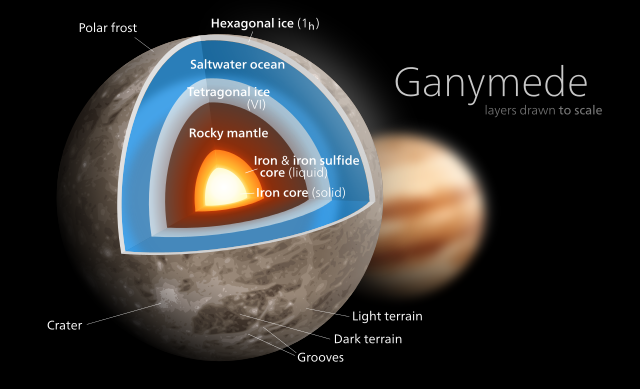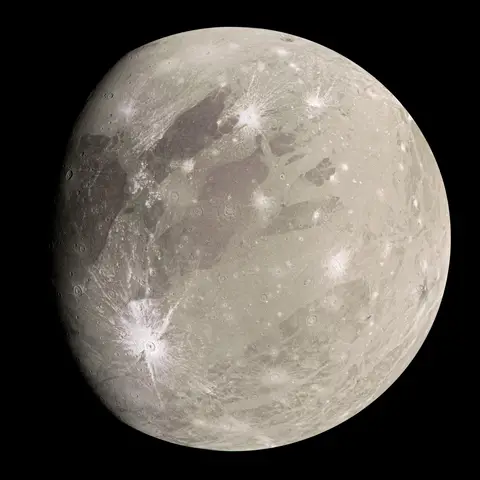Ganymede, also called Jupiter III, is the largest and most massive natural satellite of Jupiter as well as in the Solar System, being a planetary-mass moon.
Ganymede is composed of approximately equal amounts of silicate rock and water. It is a fully differentiated body with an iron-rich, liquid core, and an internal ocean that may contain more water than all of Earth’s oceans combined.
Its surface comprises of two types of terrain. Dark regions, which have an abundance of impact craters and has been dated to four billion years ago, cover about a third of it. Lighter regions, crosscut by grooves and ridges and only slightly less ancient, cover the remainder of the moon. The cause of the light terrain’s geology is not fully understood, but a theory is that it is the result of tectonic activity due to tidal heating.

Ganymede’s discovery is credited to Simon Marius and Galileo Galilei, who both observed it in 1610, as the third of the Galilean moons, the first group of objects discovered orbiting another planet.
Its name was suggested by astronomer Simon Marius, after the mythological Ganymede who was a Trojan prince desired by Zeus), who carried him off to be the cupbearer of the gods.
Beginning with Pioneer 10, several spacecraft have explored Ganymede. Both of the The Voyager probes, refined measurements of its size, while Galileo discovered its underground ocean and magnetic field.
Facts
Ganymede was one of a total of four moons discovered by Galileo Galilei in 1610
Ganymede is also called Jupiter III
It is the largest and most massive natural satellite of Jupiter
Ganymede was named after a suggestion from German mathematician and astronomer Johannes Kepler
In Greek mythology, Ganymede was a Trojan prince that became the cupbearer for the gods of Olympus
It is larger than the planet Mercury
Ganymede is the ninth-largest object in the solar system
Ganymede has a thin atmosphere that appears to contain oxygen.
Ganymede is roughly 4.5 billion years old.
Ganymede orbits Jupiter at a distance of 1,070,400 kilometres
Ganymede completes a revolution of Jupiter every seven days and 1 hour
The average density of Ganymede, 1.936 g/cm3, suggests a composition of equal parts rocky material and water ices.
Ganymede is tidally locked, with one side always facing toward the planet
Ganymede is thought to have a subsurface ocean, overlying a liquid iron and nickel core.
It has a diameter of about 5,270 kilometres
Ganymede is the only moon in the solar system known to have a substantial magnetosphere

Ganymede has 40% of its surface that is covered with a lot of dark cratered areas that are thought to be from comet or asteroid impacts.
Ganymede is in a 1:2:4 orbital resonance with the moons Europa and Io, respectively.
Pioneer 10 and 11 were launched in March 1972 and April 1973 and made successful flybys of Ganymede in December 1973 and December 1974
Voyager 1 and 2 delivered higher quality and more detailed images in 1979
The Galileo spacecraft in 1995 passed as low as 162 miles over the surfaces of the Galilean moons
Ganymede has polar caps, likely composed of water frost
The next planned mission to the Jovian system is the European Space Agency’s Jupiter Icy Moon Explorer which was launched in 2023
The evidence suggests that Ganymede’s oceans might be the largest in the entire Solar System
The radius of the core may be up to 500 km.
The temperature of the core of Ganymede is probably about 1500–1700 K
Information
| Designations | |||||||||||||
|---|---|---|---|---|---|---|---|---|---|---|---|---|---|
| Pronunciation | GAN-ə-MEED | ||||||||||||
|
Alternative names
|
Jupiter III | ||||||||||||
| Orbital characteristics | |||||||||||||
| Periapsis | 1069200 km | ||||||||||||
| Apoapsis | 1071600 km | ||||||||||||
|
Semi-major axis
|
1070400 km | ||||||||||||
| Eccentricity | 0.0013 | ||||||||||||
|
Orbital period (sidereal)
|
7.15455296 d | ||||||||||||
|
Average orbital speed
|
10.880 km/s | ||||||||||||
| Inclination | 2.214° (to the ecliptic) 0.20° (to Jupiter’s equator) |
||||||||||||
| Group | Galilean moon | ||||||||||||
| Physical characteristics | |||||||||||||
|
Mean radius
|
2634.1±0.3 km (0.413 Earths) | ||||||||||||
|
Surface area
|
8.72×107 km2 (0.171 Earths) | ||||||||||||
| Volume | 7.66×1010 km3 (0.0704 Earths) | ||||||||||||
| Mass | 1.4819×1023 kg (0.025 Earths) (2.02 Moon’s) (0.23 Mars’) | ||||||||||||
|
Mean density
|
1.936 g/cm3 (0.351 Earths) | ||||||||||||
|
Surface gravity
|
1.428 m/s2 (0.146 g) | ||||||||||||
|
Moment of inertia factor
|
0.3115±0.0028 | ||||||||||||
|
Escape velocity
|
2.741 km/s | ||||||||||||
|
Synodic rotation period
|
synchronous | ||||||||||||
|
Axial tilt
|
0–0.33° | ||||||||||||
| Albedo | 0.43±0.02 | ||||||||||||
|
|||||||||||||
|
Apparent magnitude
|
4.61 (opposition) 4.38 (in 1951) |
||||||||||||
|
Angular diameter
|
1.2 to 1.8 arcseconds | ||||||||||||
| Atmosphere | |||||||||||||
|
Surface pressure
|
0.2–1.2 μPa (1.97×10−12–1.18×10−11 atm) | ||||||||||||
Links
Have you enjoyed this you can also read about IO – Various facts about Jupiters moon Io

1 comment
[…] Various facts about Jupiters moon Ganymede […]
Comments are closed.